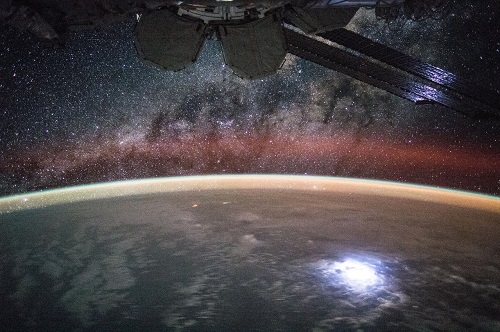Venus remains in the morning sky this month. Venus outshines everything except the Sun and the Moon, so you can try to find it low in the southeast at dawn. Venus remains a ‘morning star’ for most of 2022.
Mars is low the morning sky this month. The Red planet pulls away from Saturn this month and approaches Jupiter by May 29.
Saturn is now low in the south-southeast before dawn.
Jupiter is also in the morning sky this month. You can see it low in the east at dawn. All month Venus pulls away from Jupiter.

A swath of brilliant winter stars sets in the west at dusk. Orion, the Hunter, is still visible in the west as May begins. His two dogs, represented by Sirius and Procyon, are to his left. Gemini, the Twins, are above Orion. The Big Dipper is above the North Star, with its handle pointing to the right. From that handle, you can ‘arc to Arcturus’ and then ‘speed on to Spica’; those stars are high in the east and in the southeast, respectively, at dusk. Leo, the Lion, passes almost overhead at dusk.
As Orion and his dogs set, look for Antares, brightest star of Scorpius, the Scorpion, to rise in the southeast. At the same time, Vega, brightest star of the Summer Triangle, appears low in the northeast. These stars remind us that summer is on the way.
On May evenings, the plane of the Milky Way roughly coincides with the horizon. (At Houston’s latitude, the two planes are off by less than three degrees). We are therefore looking straight out of the Milky Way plane when we look up early on a May evening. Thus May evening skies have fewer bright stars, as we see most of the brightest stars in the Milky Way plane which is ringing the horizon.

The Big Dipper is as high as it gets in the north. Leo, the Lion, is almost overhead at dusk. From the Big Dipper’s handle, arc to Arcturus and then speed on to Spica in the south. As Orion and his dogs set in the west, Vega and Antares peek above the horizon, heralding the approaching summer.
Moon Phases in May 2022:
1st Quarter May 8, 7:21 p.m.
Full May 15, 11:14 p.m.
Last Quarter May 22, 1:43 p.m.
New May 30, 5:30 a.m.
The Full Moon of Sunday, May 15, enters the Earth’s shadow, causing a total lunar eclipse. The eclipse happens late at night, with the Full Moon high in the sky. Only cloud cover can stop us from enjoying the whole event. Partial eclipse starts at 9:27 am, totality lasts from 10:29 to 11:53, and the eclipse is over at 12:55 am on Monday, May 16. Our next total lunar eclipse is on November 8, 2022. However, that eclipse occurs in the morning, ending right as the Moon sets and the Sun rises. Thus, let’s hope for clear weather this May 15 so we can watch at convenient evening hours. Also, this Full Moon happens hear perigee (when the Moon is closest to Earth). Thus, it is ever so slightly larger than normal and becomes a ‘supermoon’.
The George Observatory will be open on May 15 especially for observing the eclipse.
Clear Skies!
Miss last month’s sky happenings? See them here.






